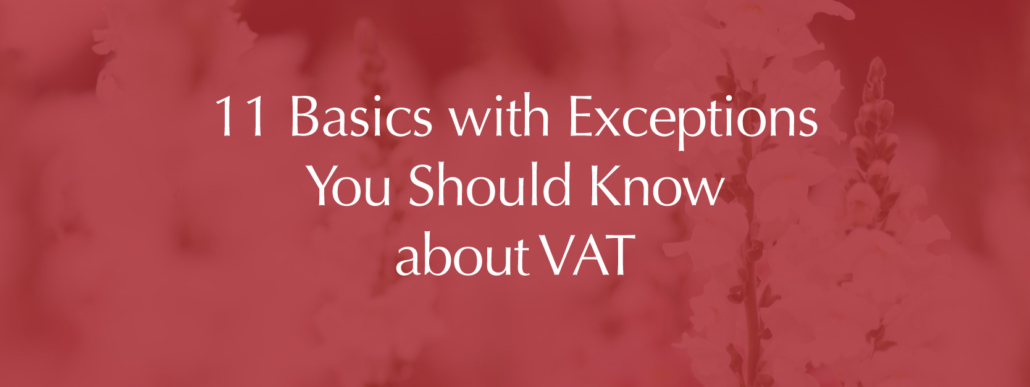11 Basics with Exceptions You Should Know about VAT

VAT is an indirect tax on consumption that is levied on the turnover of goods and services. In Estonia, a company is required to register for VAT if its sales turnover exceeds € 40,000 per calendar year. In addition to our legislation, Estonian companies selling goods to other EU countries must also comply with local limits and laws. In this article, we talk about how VAT works, who needs to register for VAT, and when VAT can be claimed back from the state.
VAT is governed by the VAT Act and it goes directly to the general costs of the State. In this case, VAT is paid by the final consumer of the goods or services, i.e. a private individual or a non-taxable company, even though the state receives the VAT from businesses.
1. In Estonia, a business is required to register for VAT when its (taxable) sales turnover exceeds € 40,000 from the beginning of the calendar year.
If the limit is not reached, the calculation will start again the following year.
- Exception: If your turnover is entirely classified as 0%, registration is optional. Registration is also optional if your turnover is abroad.
- Exception: If you sell goods from Estonia to other EU taxable persons, you are required to register for VAT even though it is classified as 0% turnover.
2. When purchasing electronic services from abroad (such as advertising on Google Ads and Facebook or e-Books), you also need to register for VAT.
It comes as a surprise to many that a company, purchasing electronic services abroad (such as online advertising, web hosting or e-books) must also register for VAT. If a business does not have a taxable turnover, its only option is a form of limited VAT payer. A limited taxable person undertakes to declare and pay VAT on purchases of electronic services, while not being entitled to deduct or deduct input tax on his goods and services. And here comes a recommendation – if possible (i.e. have a taxable turnover), immediately become a “real” VAT payer.
- Exception: If electronic services purchases are tiny and casual, buy them better on behalf of the individual and formalize it as business expense by declaration of expenditure. In this way you are not obliged to register.
3. You need to register for VAT in another EU country if you operate locally and meet the local registration threshold or if you sell goods in another EU country and have an intermediate warehouse.
For example, you sell goods on Amazon in the UK or Germany and use their FBA (fulfilled by Amazon) service, which means that you store the goods in Amazon. In this case, VAT becomes chargeable on the first sale, the local limit will not apply.
- The VAT rules of EU countries are similar but not identical. Therefore, when selling your goods or services abroad, be sure to consult with local advisors. Read more about e-commerce taxes.
4. Sometimes it makes sense to voluntarily register for VAT.
This can be useful if:
- you need to make significant investments that can be claimed back
- sell goods or services overseas (which is 0% taxable) or sell goods overseas (e.g., you buy goods from China and sell them on Amazon) and you have VAT costs in Estonia such as accounting, marketing or assistant services
- your customers are VAT-based businesses and most of your costs are VAT-related purchases.
5. From the entrepreneur’s point of view, it is most harmful to be liable to VAT if your clients are private individuals and labour costs represent a large part of the cost.
So, if your business’s annual turnover stays within that limit, you need to keep a little eye on the VAT threshold. Larger companies have no choice here, of course.
6. Turnover within Estonia is generally taxable at 20% VAT.
Books and workbooks (paper, e-books are not discounted); medicines, sanitary products, medical equipment and aids for the disabled; newspapers and magazines (other than adverts and erotica magazines) and accommodation are taxed at 9% VAT.
Exports (unless they are classified as exempt); goods transported to another Member State; ships and aircraft, their equipment, goods sold locally (except for intra-community travel) and services provided, ship port services and airport ground services, ship and aircraft repair and maintenance; goods and services sold to diplomats, EU institutions, NATO armed forces, military headquarters; goods sold in customs warehouses, free zones, excise warehouses, military headquarters; gold to be transferred to Eesti Pank; non-Estonian service (intangible and electronic); transport of goods to be exported or imported, transport of goods under customs procedure and passenger transport in Estonia, if it is part of an international journey, are taxed at 0% VAT.
- Please note that the provision of a service subject to 0% VAT will require proof, e.g. by contract or order form.
7. In order to claim VAT on your purchase invoice, the invoice must meet the requirements of the original accounting document.
Since 2017 the requirements for original accounting documents have been simplified, but this does not apply to VAT invoices. The invoice must state:
- the serial number of the invoice and the date of issue
- taxpayer name, address, tax identification number
- the name and address of the customer
- the tax identification number of the person acquiring the goods or services if he is liable for the tax when the goods or services are acquired
- the name or description of the good or service
- quantity of goods or volume of service
- the date of issue of the goods or provision of the service or the receipt of payment, in whole or in part, for the goods or services, if determinable and different from the date of issue of the invoice
- the price of the good or service, exclusive of VAT, and the discount, if not included
- the taxable amount by value added tax, together with the applicable VAT rates, or the amount of exempt turnover
- the amount of VAT due, except as provided by law.
The amount of VAT shall be expressed in euro.
- Exception: A simplified invoice may be issued if the amount invoiced is less than or equal to EUR 160 in the following cases:
- providing passenger transport services (bus tickets, boat tickets, taxi vouchers)
- for the printing of invoices of a parking machine, an automatic gas station payment terminal and similar apparatus.
In this case, the invoice must include at least:
- the date the invoice was issued
- the seller’s name and tax identification number
- the name or description of the good or service
- taxable amount
- the amount of VAT due.
You can add your company name and tax registration number to the simplified invoice.
8. The refund of input tax is subject to the use of the goods or services purchased for the purposes of VAT or business activities abroad.
If the trader has both a tax-free and a taxable turnover, the input VAT can be partially refunded. There are two different methods:
- the proportional deduction method
- mixed method of direct deduction and proportional deduction.
In case of proportional deduction, the ratio of the taxable turnover to the total turnover shall be applied to the total deduction of input tax. The ratio of taxable turnover to total turnover shall be determined on the basis of the taxable person’s turnover for the preceding calendar year. The result shall be adjusted at the end of the calendar year on the basis of the ratio of taxable turnover to total turnover for that calendar year.
Where the business has been operating less than one calendar year, the tax authority shall, by decision, determine the ratio of taxable turnover to total turnover on the basis of the estimated ratio of its taxable turnover to total turnover for the first calendar year.
In the case of a hybrid method of direct calculation and proportional deduction:
- 100% of the input tax on the goods or services acquired for the purposes of taxable turnover shall be taken into account
- the input VAT on goods or services acquired for the purposes of a tax-free turnover shall not be deducted
- input tax on goods or services acquired for both taxable and exempt transactions shall be deducted in accordance with the ratio of taxable turnover to total turnover.
9. VAT shall not be chargeable on costs incurred in receiving the visitors, catering or accommodation for their staff.
- Exception: VAT may be refunded on the cost of business trips.
10. As a general rule, 50% of the cost of a car may be refunded for VAT.
- Exception: Passenger car costs may be refunded 100% VAT if:
- the company sells or leases passenger cars and does not use them itself
- it is a study car or taxi
- it is a 100% business car (it must be noted in the Road Administration’s register and the company must prevent the car from being used for private purposes as well).
11. VAT can also be claimed on purchases made in other EU countries.
If you have purchased goods or services from other EU countries, your VAT has been correctly added to your purchase (for example – hotel bills, conference tickets, etc.) and you have correct purchase invoices (including petrol station fuel checks that meet the requirements for simplified invoices) you can claim VAT from Tax and Customs Board. To do this, you must submit an electronic application by September 30 of the following calendar year. If you refund VAT for the full calendar year, the minimum amount is 50 euros per country. You can also apply more frequently if you wish, with a minimum of 400 euros per country. See the exact procedure here: https://www.emta.ee/eng/business-client/income-expenses-supply-profits/overview-charging-value-added-tax/vat-refund
When registering a business for VAT, you need to keep in mind that your monthly accounting volume will increase significantly. While some smaller businesses can sometimes handle their accounting well, this solution cannot be recommended to a taxable person because there are too many details in the VAT issue to be aware of. If you are looking for a reliable accounting partner with experience in dealing with international sales of goods and services, check out our financial accounting service and contact us so we can talk more about how we can help you.

Leave a Reply
Want to join the discussion?Feel free to contribute!